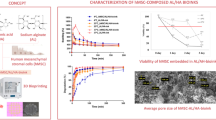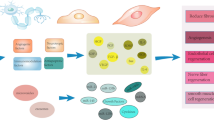Abstract
The purpose of this study was to assess whether Sertolis cells would improve functional performance of homologous pancreatic islets within microcapsules. Purified rat Sertoli's cells were co-enveloped with islets in microcapsules that had been fabricated with alginic acid and poly-L-ornithine Confocal laser microscopy was used to determine any mitogenic effects of Sertoli's cells on islets ß-cells. Insulin secretion from islets, with or without Sertoli's cells, was examined and grafts of Sertoli's cells with islets in microcapsules into diabetic mice were carried out. Co-incubation of Sertoli's cells with islets resulted in a significant increase in the islet ß-cell mitotic rate, which was coupled with significantly higher insulin release under glucose stimulation, as compared to controls. Grafts of co-microencapsulated Sertoli's cells with islets resulted in prolongation of the achieved normoglycemia in the animals receiving Sertoli's cells with islets as compared to controls that received islets only. Sertoli's cells do promote mitogenic activities upon in vitro co-incubation with islets, whose in vitro functional and in vivo post-transplant consequences were evident. Sertoli's cells could, therefore, be comicroencapsulated with islets for transplantation in diabetic recipients.
Similar content being viewed by others
References
Shpairo AM, Lakey JR, Ryan EA, et al. Islet transplantation in seven patients with type 1 diabetes mellitus using a glucocorticoid-free immunosuppressive regimen. N Engl J Med. 2000;27:230–338.
Lim F, Sun M. Microencapsulated islets as bioartificial endocrine pancreas. Science. 1980;210:908–910.
Colton CK. Implantable biohybrid artificial organs. Cell Transplant. 1995;4:415–436.
Calafiore R, Basta G. Microencapsulation of pancreatic islets: theoretical principles, technologies and practice. In: Ricordi C. ed. Methods in Cell Transplantation. New York: Landes R.G.; 1995:587–609.
Ramiya VK, Maraist M, Arfors KE, Schatz DA, Peck AB, Cornelius JG. Reversal of insulin-dependent diabetes using islets generated in vitro from pancreatic stem cells. Nature Med. 2000;6:278–282.
Finegood DT, Scaglia L, Bonner-Weir S. Dynamics of b-cell mass in the growing rat pancreas: estimation with a simple mathematical model. Diabetes. 1995;44:249–256.
Hellerstrom C. The life story of the pancreatic b cell Diabetologia. 1984;26:393–400.
Swenne I. Effect of aging on the regenerative capacity of the pancreatic b-cell of the rat. Diabetes. 1983;32:14–19.
Hellerstrom C, Swenne I. Functional maturation and proliferation of fetal pancreatic b-cells. Diabetes. 1994;40:89–93.
Jégou B. The Sertoli cell. Bailliere's Clinical and Metabolism. 1992;6:273–311.
Suarez-Pinzon W, Korbutt GS, Power R, Hooton J, Rajotte RV, Rabinovitch A. Testicular sertoli cells protect iselt b-cells from autoimmune destruction in NOD mice by a transforming growth factor bl-dependent mechanism. Diabetes 2000;49:1810–1818.
Selawry HP, Wang X, Alloush L. Sertoli cell-induced effects on functional and structural characteristic of isolated neonatal porcine islets. Cell Transplant. 1996;5:527–524.
Korbutt GS, Elliott JF, Rajotte RV. Cotransplantation of allogeneic islets with allogeneic testicular cell aggregates allows long-term graft survival without systemic immunosuppression. Diabetes. 1997;46:317–322.
Sanberg PR, Borlongan CV, Othberg AI, Saporta S, Freeman TB, Cameron DF. Testis-derived Sertoli cells have a trophic effect on dopamine neurons and alleviate hemiparkinsonism. Nat Med. 1997;3:1129–1132.
Lacy PE, Kostianovsky M. Method for the isolation of intact islets from the rat pancreas. Diabetes. 1997;46:317–322.
Galdieri M, Ziparo E, Palombi F, Russo M, Stefanini M. Pure Sertoli cell cultures: a new model for the somatic germ cell interaction. J Androl. 1981;5:249–254.
Luca G, Calvitti M, Becchetti E, et al. Method for separation, morphological and functional characterization of Sertoli's cells from the prepubertal testis: a potential nursing cell system for pancreatic islets. Diab Nutr Metab. 1998;11:307–313.
Brelje TC, Sorenson RL. Role of prolactin versus growth hormone on islets ßcell proliferation in vitro: implications for pregnancy. Endocrinology. 1991;128:45–57.
Neri LM, Raymond Y, Giordano A, Capitani S, Martelli AM. Lamina is part of the internal nucleoskeleton of human erythroleukemia cells. J Cell Physiol. 1999;178:284–295.
Neri LM, Martelli AM, Maraldi NM. Redistribution of DNA topoisomerase IIb after in vitro stabilization of human erythroleukemic nuclei by heat or Cu++ revealed by confocal microscopy. Mic Res Techn. 1999;36:179–187.
Author information
Authors and Affiliations
Corresponding author
Additional information
Published: August 26, 2001.
Rights and permissions
About this article
Cite this article
Luca, G., Calafiore, R., Basta, G. et al. Improved function of rat islets upon co-microencapsulation with Sertoli's cells in alginate/poly-L-ornithine. AAPS PharmSciTech 2, 15 (2001). https://doi.org/10.1208/pt020315
Received:
Accepted:
DOI: https://doi.org/10.1208/pt020315




